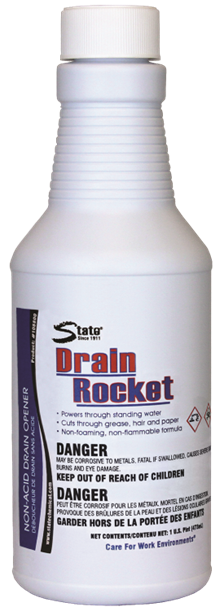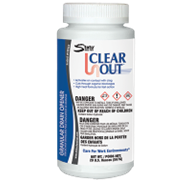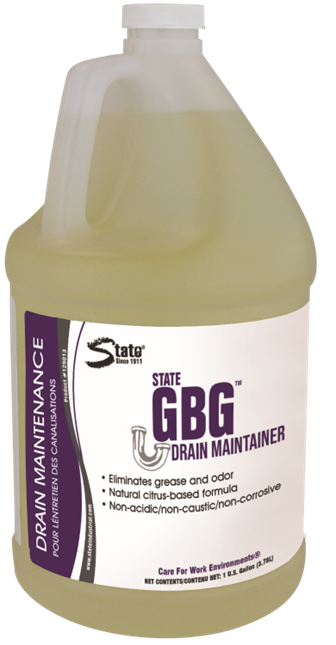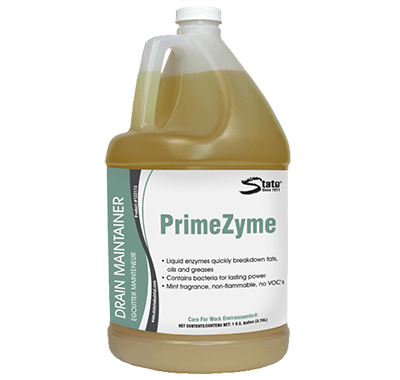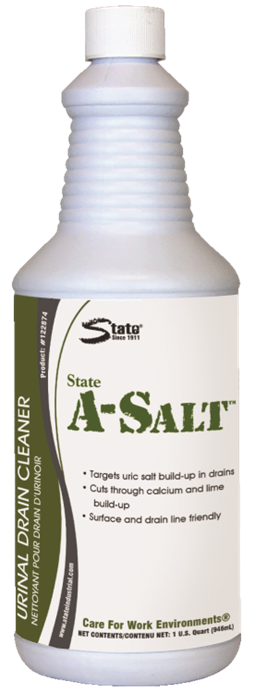What is the Best Product to Unclog My Drain?
What is the Best Product to Unclog My Drain?
Picture this: it’s a busy Friday night at your restaurant. Customers are filing through the doors, tables are packed, servers are rushing back and forth with steaming trays of food. And then you hear a commotion from the back. You find your frantic employee struggling to unclog the sink while piles of dirty plates stack higher and higher. The clog will not budge—your drain is out of commission at the worst possible time.
As the person responsible, you may be overwhelmed trying to find a solution. Yes, you need to fix the issue—and quickly—but you also need to figure out how, you need to figure out what went wrong, you need to get your facility back up and running, you need to stay within budget. With so much to consider, it can be difficult to know where to start.
Here at State Chemical, we hear these concerns every day, and we have for over a hundred years. We understand that with so many potential options to explore, it can be difficult to get down to the real problem and its most efficient solution. That’s why it’s our goal to provide you with transparent information about our products so that you can find the drain opener to solve your issue.
We offer unique drain openers designed for different needs, such as drain type, ingredients used, chemical regulations, effectiveness, and safety. For your convenience, we have taken the time to compare these products and their appropriate uses to enable you to make the right decision.
In this article, we will cover the following:
- What Causes Drain Clogs?
- What is a Drain Opener?
- Which Drain Opener Will Solve My Problem?
- Can I Use a Drain Maintainer to Unclog My Drain?
- How Do I Properly Use a Drain Opener?
- So, What is the Best Product for Me?
What Causes Drain Clogs?
You may have noticed your drain blockage and wondered what caused this. You haven’t been throwing trash down it; why is it suddenly backed up? Drain clogs can be caused by many different factors—sometimes things that we don’t realize are contributing to blockages.
Fats, Oils, and Greases (FOGs)
Some of the most common drain issues are caused by FOG buildup. For example, if bacon grease is poured down the sink, it will congeal in the pipes, especially where there are twists and turns. The more frequently the bacon grease is dumped down the drain, the more it will build up. This on its own can slow down or clog a drain, but the issue is worsened when other foreign objects like organics are put down the drain.
Organics
Organics like hair and food can cause clogs as well. These clogs are only worsened when combined with those from FOGs.
For example, hair won’t usually clog a drain on its own, but when it gets caught in built-up body oils and soap scum, it will cause issues. Meanwhile, certain foods like rice or pasta will create issues on their own by creating blockages and absorbing water—the presence of FOGs only makes it easier for them to get stuck in the pipes. This is why it’s important to watch what’s going down the drain and avoid problematic items as much as possible.
Paper Products and Cotton
Some of the most troubling clogs will be caused by products like diapers, wipes, and bedsheets depending on your facility.
In a nursing home, for example, residents may flush diapers down the toilet rather than dispose of them in the trash. What they may not realize is that drains aren’t built to handle these products and that they are likely to get clogged, especially in situations where the drain is already dealing with FOG buildup. Educating staff and facility users about what can and cannot go down a drain is imperative to avoiding these more intensive blockages.
Sediment
Another potential cause of drain clogs that you may not think of is sediment. Think about the dirt and debris that may get picked up when you’re mopping your floors, for example. If what’s picked up by the mop ends up dumped in the sink, you could be dealing with dirt and rocks settling into your drain lines and causing clogs.
What is a Drain Opener?
Now you understand what causes a clogged drain, but to fix your issue, we must establish what a drain opener is—and what it is not.
Drain openers are a reactive approach to a clogged drain. In other words, they are to be used when the drain is blocked and water will not pass through it, or they can also be used for slow drains. At these points, it’s clear that there is already an issue with a drain blockage, and a drain opener will be needed to resolve the issue.
This is different from a drain maintainer, which is generally used as a preventative treatment to stop drain blockages from happening in the first place. Most drain maintainers should not be used to treat clogged drains since they won’t usually have any significant impact on an already-formed clog. However, it is important to note that certain drain maintainers can treat slow drains. But for the most part, if your aim is to prevent future drain clogs, eliminate drain fly habitats, treat dry drain, or otherwise maintain your drains, we recommend that you read “How to Choose A Preventative Drain Cleaner: 5 Factors to Consider.”
Which Drain Opener Will Solve My Problem?
As you explore, ask yourself: do I prefer acid or non-acid? How severe is the clog? What most likely caused the clog? Are there any city regulations I need to ensure I follow? State Chemical offers three main drain openers for different preferences and types of clogs.
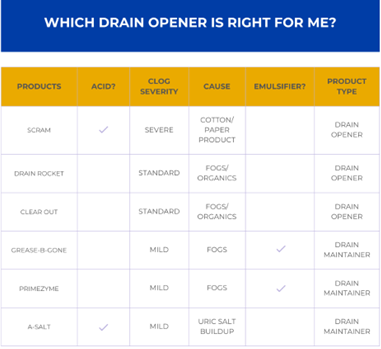
SCRAM
Regarded as the most heavy-duty drain opener State Chemical offers, SCRAM is a sulfuric acid liquid drain opener. SCRAM is designed to be activated by water, so once it hits the drain, it sinks and disintegrates the clog.
If you have an acid preference, SCRAM is a strong choice, but it is designed for severe situations. The product is strong enough that it can potentially cause damage to older pipes, weakened cast iron pipes, rusted-over pipes, and porcelain. That said, SCRAM is a tried-and-true product that works quickly and efficiently to decimate your clog, but we recommend it only be used in extreme situations, such as for paper or cotton clogs.
When handling, wear personal protective equipment (PPE), as with all drain openers. We also recommend wearing a face shield.
Drain Rocket
A non-acid liquid bowl cleaner that’s heavier than water, Drain Rocket is a caustic drain opener that’s able to sink straight to the cause of the clog. From there, it generates heat and ends up boiling and pushing the clog out.
Drain Rocket is best for standard clogs, like those in a shower drain or kitchen sink involving grease, soap scum, or organics. Since it’s non-acidic, it’s considered a safer option than acidic drain openers like SCRAM, and it’s easy to use, with users typically just pouring a pint bottle down the drain in question.
If your drain clog is more severe, Drain Rocket is not the product for you, but it is effective for standard blockages.
Clear Out
Somewhat similar to Drain Rocket, Clear Out is a granular drain opener that sinks to the source of a clog before activating, where it will reach 212° Fahrenheit to melt the clog. From there, the melted clog can pass easily through the pipes.
Clear Out is generally considered less dangerous than liquid drain openers since there is less risk for splash back and it is easier to apply. It is also more economical with 25 uses per bottle and up to 200 uses per case. It also leaves behind a refreshing lemon scent whereas sulfuric acid drain openers tend to have an odor of rotten eggs.
It is also possible to use Clear Out as a form of preventative drain maintenance, such as for avoiding slow drains, but if you are not experiencing clogged drains, it may be more cost-effective to go for a traditional drain maintainer.
Can I Use a Drain Maintainer to Unclog My Drain?
Traditionally, drain maintainers are to be used as preventative drain care, and not all of them will be effective for unclogging drains. However, certain drain maintainers can unclog slow drains. These products should not be used for fully blocked drains or more severe situations, but they come in handy for treating a mild drain block before it gets worse. State Chemical sells several drain maintainers that can help unblock slow drains.
Grease-B-Gone
While not a true drain opener, Grease-B-Gone works so quickly that it can be used in place of one in the case of slow drains. Composed mainly of orange oil, Grease-B-Gone is an emulsifier that breaks down FOGs.
Grease-B-Gone is best used for slow shower drains and kitchen drains. However, it is an expensive option, so PrimeZyme may be more cost-effective as a drain maintainer. Additionally, since Grease-B-Gone is an emulsifier, it’s important to know your local laws and whether emulsifiers are legal in your area.
PrimeZyme
Containing both bacteria and enzymes, PrimeZyme can sometimes be used as a drain opener for slow drains.
PrimeZyme contains good bacteria, which feed on organic buildup in drains and digest them into carbon dioxide and water, removing buildup. These bacteria double every twenty minutes, so as long as there are organics for them to feed on, they continue clearing the drain lines.
If your drains are slow, PrimeZyme can be a good option to fight back against buildup and continue maintaining your drains even after the initial issue is resolved. Grease-B-Gone is more effective than PrimeZyme, but PrimeZyme is more cost-efficient, so the choice really depends on what you’re looking for.
A-Salt
An additional drain maintainer that can be used to open slow drains is A-Salt. It is important to note that this option can only be used in urinals to deal with uric salt buildup.
If your urinals’ uric salt buildup is bad enough to be causing slow drains, A-Salt is an effective option to break down this buildup and get the drains back in working order. From there, it can be used as a weekly preventative treatment to stop the drains from getting to that point again.
How Do I Properly Use a Drain Opener?
When handling a drain opener, be sure to familiarize yourself with the product’s individual safety information and directions. Each product label will have directions about how to use it, using the correct amount, and proper handling.
Wear PPE when handling all drain openers. This means putting on protective clothing, gloves, goggles, and potentially a face shield. And never look down over a drain to see if the product is working. Chemicals could splash back and cause you bodily harm.
So, What is the Best Product for Me?
A lot of variables go into deciding on a drain opener. When you’re overwhelmed by the chaos of a drain clog, it can be hard to quickly make an informed decision, but with this information, you’re now prepared to select the solution best for your situation. Now that you have a better idea of what kind of drain opener you need, it’s time to take the next step on your journey and choose a drain cleaning company.


